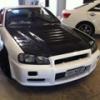Oil Control In Rb's For Circuit Drag Or Drift
Announcements
-
Similar Content
-
Latest Posts
-
By Dose Pipe Sutututu · Posted
full send the cnut, do this fark the wrapping and/or stick on siet. These guys are the ones to go to: https://www.realthermo.com.au/ -
By Dose Pipe Sutututu · Posted
Just had a look, they don't. Fuelling on the base map is purely alpha-N, and the ignition table is MAP. Remember it's just a base map to get the car moving -
Hi everyone, I’m Dave from Canberra. Here's a few pics of my 1992 R32 GTST coupe which I imported back in 2006. Only mods so far are HKS Hi-power cat back exhaust, K&N filter, ATC Volanti steering wheel, Pioneer stereo, amp and sub. This was my daily driver up until 2015 and sadly hasn’t been driven at all in the last 5 years due to marriage, work, and kids taking up most of my time and spare cash.As such its in need of a bit of TLC and one of my goals for this year is to get it back to running condition and maybe look into club/historic rego. I’ve joined SAU so I can ask a few questions along the way (although I promise to google Current Problem +SAU beforehand!)
-
From talking to the mx5 guys the NC doesn't actually need bonnet vents like the earlier NA and NB models, due to a better designed cooling system and undertray design There's plenty of them used as street cars and weekend track toys running anywhere from around 170 to 250kw with stock non vented bonnets, I initially was going to get some bonnet vents, but, as they are not actually required, I'll put vents on hold for a while and just monitor temps, though I do need to get something to actually monitor engine oil temps though, coolant temp can be pulled from the OBD2, but the oil gauge in the car is not actual oil temp, it is only a calculation based off coolant temp and RPM ☹️ They do recommend upgrading the radiator, which I have already done with a triple pass, and the only other thing they recommend for a street car is heat management, like I talked about above to protect bits in the engine bay from radiant heat, and to either replace the nearly 20 year old plastic coolant expansion tank, which I have done, or get a aftermarket alloy jobbie for some bling They did also say that if I wanted to track the car on occasion a oil cooler and sump baffle would be required, and as I already have had a sump baffle installed when the engine was out......... I'm going to get a oil cooler with a thermostat....... just in case I do eventually track the car, but probably not, but still maybe...🤪







Recommended Posts
Create an account or sign in to comment
You need to be a member in order to leave a comment
Create an account
Sign up for a new account in our community. It's easy!
Register a new accountSign in
Already have an account? Sign in here.
Sign In Now